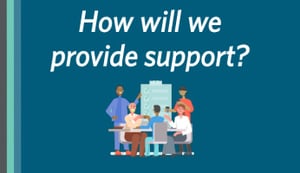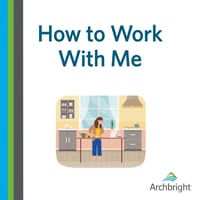Hiring for Neurodiversity
Note: To respect differing preferences, this article uses both person-first language and identity-first language.

Note: To respect differing preferences, this article uses both person-first and identity-first language.
Neurodiversity, according to neurologists Nicole Baumer and Julia Frueh, is “the idea that people experience and interact with the world around them in many different ways; there is no one ‘right’ way of thinking, learning, and behaving, and differences are not viewed as deficits. The word neurodiversity refers to the diversity of all people, but it is often used in the context of autism spectrum disorder (ASD), as well as other neurological or developmental conditions such as ADHD or learning disabilities.”
There are many benefits to hiring neurodiverse employees. A recent study even showed that employers with the greatest focus on disability inclusion achieved an average of 28% higher revenue. Despite this, Cornell University’s 2018 Disability Status Report showed that the employment rate for working-age people with cognitive disabilities in the US was 28.6 percent. For working-age people without disabilities, that number was 80 percent. While some cognitive disabilities preclude participation in the workforce, many of these people do have the capacity, need, and desire to attain employment. What’s stopping them?
One key challenge lies in how employers find and evaluate applicants. As Robert D. Austin and Gary P. Pisano, co-authors of the article “Neurodiversity as a Competitive Advantage,” point out, “The behaviors of many neurodiverse people run counter to common notions of what makes a good employee—solid communication skills, being a team player, emotional intelligence, persuasiveness, salesperson-type personalities, the ability to network, an intolerance of disorder and need for routine, a need for individual accommodations, and so on. These criteria systematically screen out neurodiverse people.”
Haley Moss, an attorney and autistic self-advocate, has described the traditional, interview-based pathway to employment as “a nonstarter.” She writes, “That process seemed primed to surface my weaknesses: I am autistic, and sometimes I feel uncomfortable in settings with elaborate and unclear social norms.” Unfortunately, screening and assessment methods often evaluate candidates on their social skills, even when they are unrelated to the job itself.
Additionally, interviews typically allow little time for candidates to process information, respond to questions, or perform tasks—and little flexibility in how they do so. Repetitive clicking of a pen might annoy interviewers, but it could support an applicant with ADHD in focusing on the conversation. Illegible handwriting on an application or related materials could be viewed as sloppiness or laziness, but it may simply reflect differences in an autistic person’s fine motor skills.
Finally, it’s impossible to overlook the role that discrimination plays against people with disabilities in the hiring process. Too many hiring managers hold ill-informed or outdated beliefs about the skills and abilities of disabled applicants. And this discrimination becomes more pronounced when these applicants are people of color. According to the Disability & Philanthropy Forum, racism and ableism are intertwined and have devastating impacts on individuals, both in school and the workforce.
Organizations that take the work of disability inclusion seriously should look critically at their recruitment and hiring processes. We have some recommendations for employers seeking to hire and retain more neurodiverse talent.

Ask leadership: When our organization hires neurodiverse employees, how will we support them? Can non-disabled co-workers provide a certain amount of assistance with workload management or prioritization? Are there social partner organizations in the area that can provide job and life skills coaching? Can the organization implement internal anti-bias training? These efforts will allow neurodiverse talent to succeed in their new roles.
A great resource for those new to this work is the Autism @ Work Playbook, developed by the University of Washington’s ACCESS-IT program. It highlights case studies of organizations that have implemented inclusive hiring programs for people with autism, including Microsoft and JPMorgan Chase. Even if the scope of your program is broader than autism, it includes many valuable ideas and considerations for all hiring efforts in the neurodiversity space. The Employer Assistance and Resource Network on Disability Inclusion (EARN) also has valuable resources on its website, including where to find candidates with disabilities. And for those who find the accommodation process overwhelming, the Job Accommodation Network (JAN) has a comprehensive toolkit.
When starting this work, be sure to preserve employee choice in participating in any programs or initiatives. Avoid spotlighting disabled employees who may not appreciate this attention, and do not put pressure on anyone to disclose their disability. Legal implications aside, they may not feel safe or comfortable doing so. Instead, it can be helpful for initiatives to, in part, acknowledge neurodiversity as it applies to all employees.

For example, the article “How to Attract and Support Neurodiverse Talent” describes Cockroach Labs, a software company based in New York City, where new hires create a ‘how to work with me’ document that forms the basis of their interactions with colleagues and includes details such as their preferred work hours, ways of giving and receiving feedback, and communication methods. This unique approach encourages employees to become more self-aware and validates the differing needs and preferences of everyone in the organization.
Again, to avoid a discrimination charge, an employer should never inquire about an applicant’s medical history or disability status and must consistently treat all similarly qualified applicants. Whether a candidate decides to share a diagnosis, your recruitment and hiring process should stay the same. Continue to research and grow in your knowledge of neurodiversity, consider using nontraditional screening and assessment methods, and plan thoughtful and inclusive interviews.
Archbright members have access to a comprehensive Video Training Library in mozzo, which includes microlearning videos such as Equitable Hiring (Parts 1 and 2), Emotional Intelligence—The Awareness Wheel, Being an Ally, and Recruiting for Neurodiversity (Parts 1 and 2). Contact us at info@archbright.com to see how you can get access.
.jpg)
Note: To respect differing preferences, this article uses both person-first language and identity-first language.

This article was originally published to the Archbright Blog on 5/25/21.

Below is the first article in a series exploring topics and learning from the 2021 NW Diversity Learning Series – Speak Up, Speak Out: Get into Good...